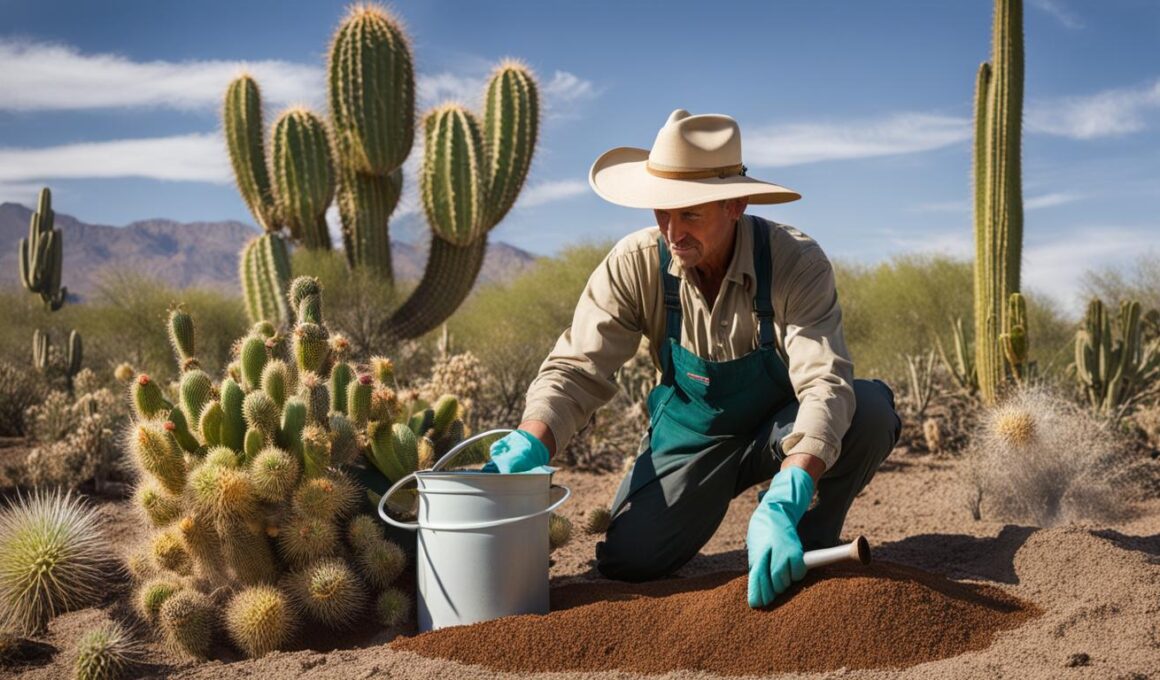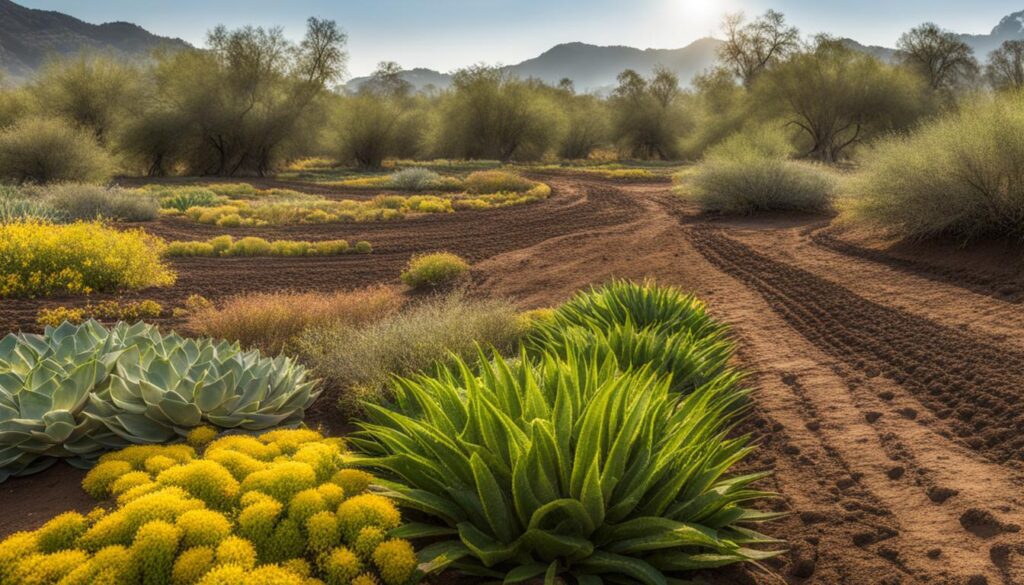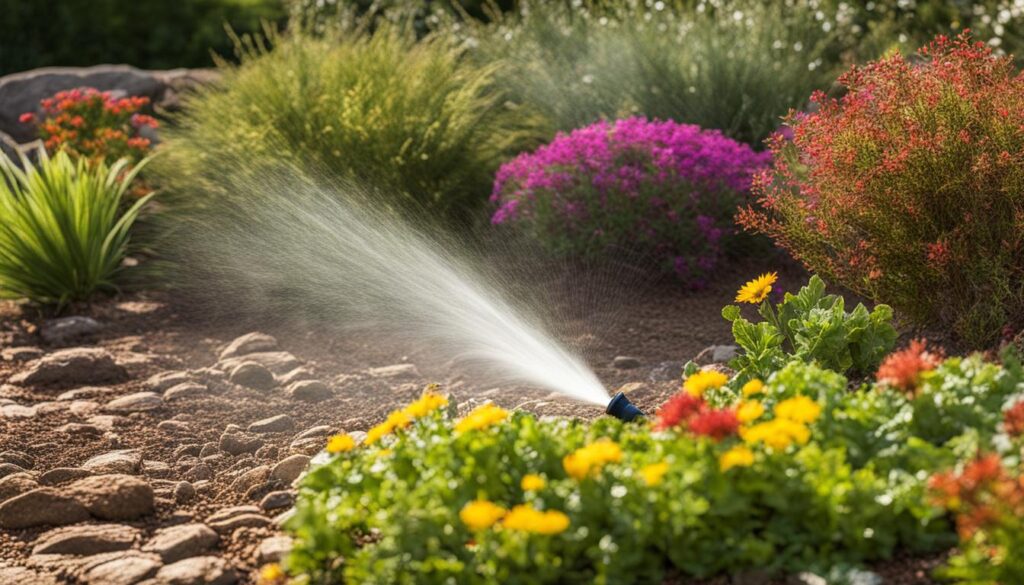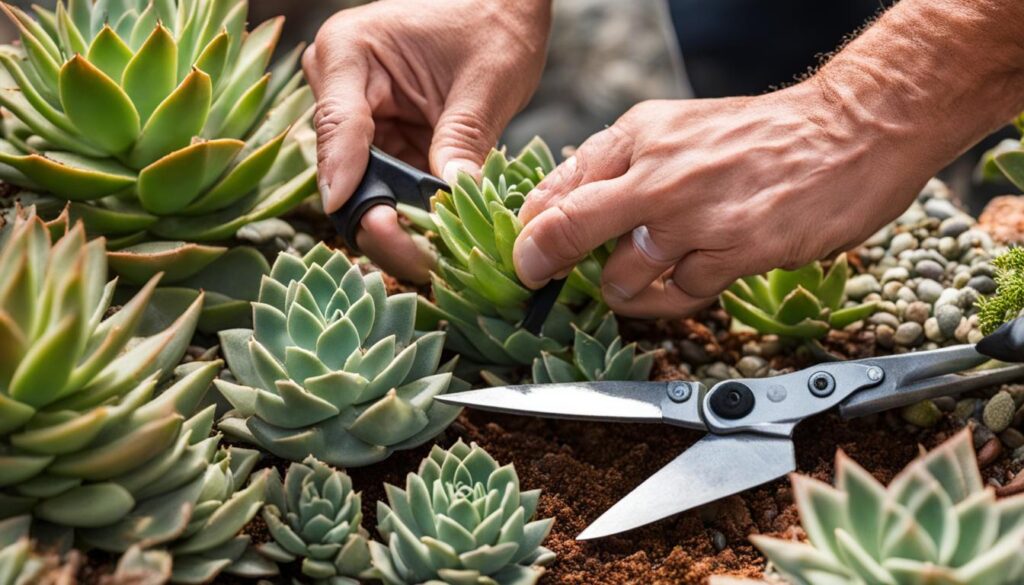Fertilizing your xeriscape is crucial for maintaining a healthy and thriving drought-tolerant landscape. By applying appropriate fertilization techniques, you can enhance the growth and vitality of your xeriscape plants.
Key Takeaways:
- Proper fertilization is essential for the health of your xeriscape plants in a drought-tolerant landscape.
- Follow specific fertilization guidelines for native and non-native xeriscape plants.
- Consider using compost or organic fertilizer for lawns in xeriscapes to improve soil texture and root health.
- Fertilize only established plants and follow product label recommendations.
- Enhance the growth and vitality of your xeriscape plants by providing appropriate fertilization based on their specific needs.
Importance of Watering in Xeriscape Maintenance
Proper watering is a crucial aspect of maintaining your xeriscape and promoting efficient water use. By following the principles of deep and infrequent watering, you can provide adequate moisture to your plants while minimizing water waste. Deep watering refers to the practice of allowing water to penetrate deeply into the soil, encouraging plant roots to grow deeper and become more drought-tolerant. Infrequent watering, on the other hand, involves watering less frequently but with larger amounts of water to ensure that the soil is thoroughly soaked.
Efficient water use is essential for the health and survival of your xeriscape plants. It not only conserves water but also helps plants develop stronger root systems and become more resilient to dry conditions. By avoiding frequent shallow watering, you can discourage shallow root growth and encourage deeper root development. This allows plants to access water stored deeper in the soil, reducing their dependence on regular watering and making them more resistant to drought.
“Deep and infrequent watering is key to maintaining a healthy xeriscape. By watering deeply, you encourage roots to grow deeper, which helps plants withstand dry conditions. Infrequent watering prevents shallow root growth and encourages plants to become more drought-tolerant.”
When watering your xeriscape, it is important to monitor the moisture levels of the soil and adjust your watering schedule accordingly. Overwatering can be just as harmful as underwatering, as it can lead to root rot and other moisture-related problems. By ensuring that your plants receive the right amount of water at the right time, you can promote their overall health and longevity.
Few key points:
- Deep and infrequent watering promotes drought-tolerant root growth.
- Efficient water use reduces water waste and enhances plant resilience.
- Monitor soil moisture levels to avoid overwatering or underwatering.
Fertilizing Guidelines for Xeriscape Plants
Fertilization plays a crucial role in maintaining the health and vitality of your xeriscape plants. However, it is important to note that fertilization needs can vary depending on the type of plants in your landscape. Native desert plants, which are well-adapted to nutrient-poor soils, often do not require supplemental fertilizers. These resilient plants have evolved to thrive in harsh conditions and can extract the necessary nutrients from the soil.
On the other hand, non-native plants in your xeriscape may benefit from the addition of specific nutrients. It is recommended to follow product label recommendations when choosing fertilizers for these plants. By providing the right nutrients, you can support their growth and ensure they receive the necessary elements for optimal health.
When applying fertilizers to your xeriscape, it is essential to focus on established plants only. Young and newly planted specimens need time to establish their root systems before they can effectively utilize added nutrients. By waiting until your plants are established, you can avoid overstimulating growth and potentially causing harm. Patience is key when it comes to fertilizing your xeriscape plants.
Another aspect to consider for maintaining a healthy xeriscape is the soil quality. Adding a light top dressing of compost or organic fertilizer can improve the texture of the soil, enhancing its ability to retain moisture and provide a favorable environment for plant roots. This practice is particularly beneficial for xeriscape lawns, as it promotes healthy root development and overall lawn health.
Summary:
- Native desert plants in xeriscapes often do not require supplemental fertilizers, as they have adapted to nutrient-poor soils.
- Non-native plants may benefit from the addition of specific nutrients, and it is important to follow product label recommendations.
- Only fertilize established xeriscape plants, avoiding stimulating growth in young or newly planted specimens.
- Adding a light top dressing of compost or organic fertilizer can improve soil texture and promote healthy root development.
Weed Control in Xeriscape Landscapes
Weeds can quickly overrun and disrupt the beauty of your xeriscape landscape, so effective weed control is essential. By implementing proper strategies and preventive measures, you can keep your xeriscape free from invasive plants and ensure the health of your drought-tolerant plants.
Preventing Weed Growth
Prevention is the first line of defense against weeds in your xeriscape. Here are some measures you can take to minimize weed growth:
- Mulching: Applying a layer of organic mulch, such as wood chips or straw, can help suppress weed growth by blocking sunlight and reducing soil temperature.
- Hand Weeding: Regularly inspect your xeriscape and remove any weeds manually before they have a chance to produce seeds and spread.
- Proper Plant Spacing: Planting your xeriscape plants close together can create a dense canopy that shades the soil, making it difficult for weeds to establish.
Minimizing Soil Disturbance
One effective strategy for reducing weed problems in your xeriscape is to minimize soil disturbance. When installing your landscape, avoid unnecessary tilling or digging, as this can bring dormant weed seeds to the surface where they can germinate and grow. Instead, opt for practices like sheet mulching or using landscape fabric to suppress weed growth before planting.
Spot Treatment and Organic Weed Control
If weeds do appear in your xeriscape despite preventive measures, it’s important to address them promptly. Spot treatment with herbicides can be effective, but be cautious when using chemical controls as they can also harm desirable plants. Alternatively, you can opt for organic weed control methods, such as using vinegar-based solutions or pulling weeds by hand.
Pruning Techniques for Xeriscape Plants
Proper pruning is crucial for maintaining the health and vitality of your xeriscape plants. By implementing effective pruning methods, you can promote efficient water use and ensure optimal plant growth. Avoid the common practice of shearing, as it can stimulate new growth and increase water demand.
Instead, focus on selective pruning to remove dead or damaged branches, thin out crowded areas, and shape the plants. This encourages better airflow, reduces disease risk, and allows the plant to allocate resources efficiently. Remember to use clean, sharp tools to make clean cuts and minimize damage to the plant.
H3: Pruning Guidelines:
- Identify the correct time to prune each specific plant species. Some plants prefer to be pruned in late winter or early spring, while others benefit from pruning in late summer or early fall.
- Remove any dead, diseased, or crossing branches to maintain plant health and prevent further damage or infection.
- Thin out dense areas to improve airflow and minimize the risk of fungal diseases.
- Shape the plant by selectively cutting branches to maintain its desired form and size.
- Avoid excessive pruning, as it can stress the plant and hinder its ability to withstand drought conditions.
Remember, proper pruning methods can enhance the aesthetics of your xeriscape while promoting water efficiency. By understanding the specific needs of your plants and following these guidelines, you can ensure their long-term health and resilience.
Implementing the right pruning techniques is essential for the overall success of your xeriscape landscape. It not only promotes efficient water usage but also enhances the visual appeal of your plants. Make sure to educate yourself on the specific requirements of each plant species in your xeriscape and always follow appropriate pruning practices. By doing so, you can maintain a vibrant and thriving xeriscape that will continue to beautify your outdoor space while conserving water.
What Type of Fertilizer Is Best for Native Plants in a Xeriscape Garden?
When xeriscaping with native plants, it’s best to use a low-nitrogen, slow-release fertilizer to avoid promoting excessive growth. Look for a fertilizer specifically formulated for drought-tolerant plants, as they will provide the necessary nutrients without causing harm to the delicate balance of a xeriscape garden.
Mowing Tips for Xeriscape Lawns
Proper mowing is essential for maintaining a healthy and water-efficient xeriscape lawn. By following these mowing tips, you can ensure that your lawn stays lush, green, and resilient, while minimizing water usage and promoting deep root growth.
Maintain the Proper Mowing Height
When it comes to mowing your xeriscape lawn, it’s important to avoid cutting the grass too short. Set your mower blade to the highest recommended setting or leave the grass at a height of about 2.5 to 3 inches. Taller grass shades the soil, reducing evaporation and weed growth, while also encouraging the development of deep roots that can access moisture from deeper in the soil.
Use a Mulching Mower
A mulching mower is a great tool to use for xeriscape lawn maintenance. It cuts the grass into fine clippings that are left on the lawn, acting as a natural mulch that conserves moisture and returns nutrients to the soil. This reduces the need for additional watering and fertilization, while also improving the overall health of your lawn.
Mow Regularly, but Don’t Overdo It
Regular mowing is essential to keep your xeriscape lawn looking its best. However, avoid mowing too frequently, as it can stress the grass and increase its water requirements. Aim to mow when the grass reaches a height of around 4 inches, cutting no more than one-third of the grass length at a time. This helps maintain a healthy and drought-tolerant lawn while minimizing water usage.
By following these mowing tips, you can ensure that your xeriscape lawn remains beautiful and water-wise. Remember to adjust your mowing practices according to season and weather conditions, allowing your lawn to thrive while conserving water.
Conclusion
Proper maintenance is essential for the long-term success of your xeriscape landscape. By implementing water-wise practices and following appropriate care techniques, you can ensure optimal growth and vitality of your drought-tolerant plants.
Remember to prioritize the specific needs of your xeriscape plants, whether they are native or non-native, to promote their health and sustainability. Watering efficiently, fertilizing appropriately, controlling weeds, pruning correctly, and mowing at the right height are all key components of xeriscape landscape maintenance.
By following these guidelines, you can create a beautiful and sustainable xeriscape that not only conserves water but also enhances the overall beauty of your outdoor space. With a little effort and attention to detail, your xeriscape will thrive, providing you with a low-maintenance landscape that is both aesthetically pleasing and environmentally friendly.














